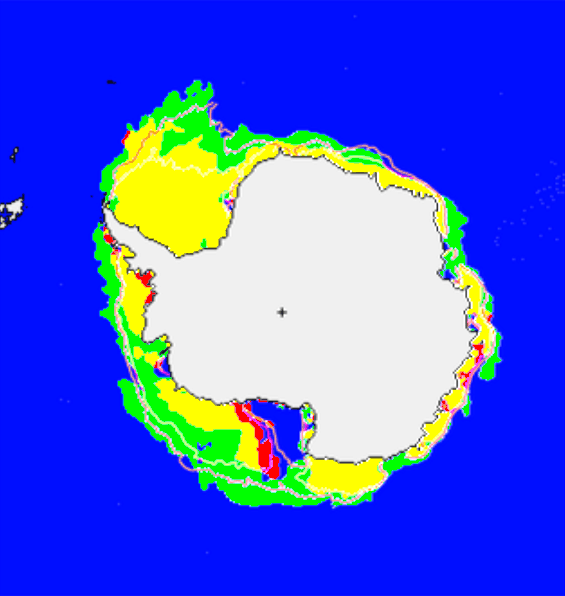Green is ice present in 2013, which was not present in 1992. Red shows the opposite.
Disrupting the Borg is expensive and time consuming!
Google Search
-
Recent Posts
- Fact Checking NASA
- Fact Checking Grok
- Fact Checking The New York Times
- New Visitech Features
- Ice-Free Arctic By 2014
- Debt-Free US Treasury Forecast
- Analyzing Big City Crime (Part 2)
- Analyzing Big City Crime
- UK Migration Caused By Global Warming
- Climate Attribution In Greece
- “Brown: ’50 days to save world'”
- The Catastrophic Influence of Bovine Methane Emissions on Extraterrestrial Climate Patterns
- Posting On X
- Seventeen Years Of Fun
- The Importance Of Good Tools
- Temperature Shifts At Blue Hill, MA
- CO2²
- Time Of Observation Bias
- Climate Scamming For Profit
- Climate Scamming For Profit
- Back To The Future
- “records going back to 1961”
- Analyzing Rainfall At Asheville
- Historical Weather Analysis With Visitech
- “American Summers Are Starting to Feel Like Winter”
Recent Comments
- Bob G on Fact Checking NASA
- Bob G on Fact Checking NASA
- Bob G on Fact Checking NASA
- arn on Fact Checking NASA
- Gordon Vigurs on Fact Checking NASA
- Bob G on Fact Checking NASA
- Bob G on Fact Checking NASA
- arn on Fact Checking NASA
- conrad ziefle on Fact Checking NASA
- conrad ziefle on Fact Checking NASA



The extra red shows the Ross Ice Shelf has grown since 1992. Blue shows sea that has no sea ice, but the reason there is no sea ice there is, it’s shelf ice.
Interesting. Are you sure about that?
Ross said, “We have as much chance sailing through that as we do sailing through the White Cliffs of Dover.”
Satellite pix show no ice in the Ross Sea today.
http://www.arctic.io/explorer/aKemW/2014-01-01/6-S79.00873-E178.04026
OK, so on this map the ice shelves are white like the continent. Gotcha.
It’s died of old age. Turney says they got stuck because it was old ice. He does not go on to explain how no ice suddenly becomes old ice.
Old or new, the ice has not melted away, thus the planet can not be that warm.
Unless warmists have a theory to explain why old ice is not affected by warm temperatures?
Green and yellow stuff only as far as the camera can see
http://www.antarctica.gov.au/webcams/aurora
Why is there no sea ice in the Ross Sea. Totally baffled.
I am sure the answer will be ‘global warming’
Southerly winds are pushing the ice away from the pole
From Wiki:
The Ross Sea circulation, dominated by polynya processes, is in general very slow-moving. Circumpolar Deep Water (CDW) is a relatively warm, salty and nutrient-rich water mass that flows onto the continental shelf at certain locations in the Ross Sea. Through heat flux, this water mass moderates the ice cover. The near-surface water also provides a warm environment for some animals and nutrients to excite primary production. CDW transport onto the shelf is known to be persistent and periodic, and is thought to occur at specific locations influenced by bottom topography. The circulation of the Ross Sea is dominated by a wind-driven gyre. The flow is strongly influenced by three submarine ridges that run from southwest to northeast. Flow over the shelf below the surface layer consists of two anticyclonic gyres connected by a central cyclonic flow. The flow is considerable in spring and winter, due to influencing tides. The Ross Sea is covered with ice for much of the year and ice concentrations and in the south-central region little melting occurs. Ice concentrations in the Ross Sea are influenced by winds with ice remaining in the western region throughout the austral spring and generally melting in January due to local heating. This leads to extremely strong stratification and shallow mixed layers in the western Ross Sea.[14]
Reblogged this on wwlee4411 and commented:
The ice was supposed to be gone by 2013. Now this? What does it tell you about “Global Warming?”
Newsflash: Aurora Australis told to hold station.
Chinese rescue icebreaker stuck in the ice after the “rescue” of the guardian Stunt Team.
This episode just gets better day by day.
http://www.theguardian.com/world/2014/jan/03/second-antarctic-rescue-aurora-australis-on-standby
You had to know someone would come up with a video of Hitler trapped in Antarctic ice.
http://www.youtube.com/watch?v=03SWGkxt72A#t=36
Thats Gold!!!
That would make Al Gore wet his pants in anger! ROTFLMAO!